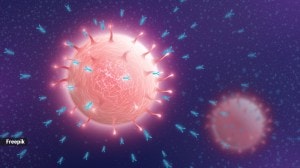Scientists discover new ‘quasicrystal’ in Nebraska, US: What are quasicrystals?
Quasicrystal is essentially a crystal-like substance. However, unlike a crystal, in which atoms are arranged in a repeating pattern, a quasicrystal consists of atoms that are arranged in a pattern that doesn’t repeat itself regularly.
 For the longest time, physicists believed every crystalline arrangement of atoms must have a pattern that repeats itself perfectly over and over again. However, the belief was broken when in 1982, a material scientist, Dan Shechtman, discovered crystal structures that are mathematically regular, but that do not repeat themselves (Photo: Wikimedia Commons)
For the longest time, physicists believed every crystalline arrangement of atoms must have a pattern that repeats itself perfectly over and over again. However, the belief was broken when in 1982, a material scientist, Dan Shechtman, discovered crystal structures that are mathematically regular, but that do not repeat themselves (Photo: Wikimedia Commons) Scientists have discovered a new type of quasicrystal, one with 12-fold symmetry, in the Sand Hills of north central Nebraska, USA, according to a recent study. It said that this quasicrystal was formed during an accidental electrical discharge, possibly by a lightning strike or a downed power line in a dune.
Quasicrystal is essentially a crystal-like substance. However, unlike a crystal, in which atoms are arranged in a repeating pattern, a quasicrystal consists of atoms that are arranged in a pattern that doesn’t repeat itself regularly.
Published in Proceedings of the National Academy of Sciences (PNAS), the study, ‘Electrical discharge triggers quasicrystal formation in an eolian dune’, has been done by Luca Bindi of the University of Florence (Italy), Paul Steinhardt of Princeton University (USA) and others.
According to the study, it’s also the first time that researchers have found a quasicrystal somewhere other than meteorites or the debris from nuclear blasts. Notably, scientists have been producing them in laboratories for years now, but it’s quite rare to discover naturally occurring quasicrystals.
“The dodecagonal quasicrystal is an example of a quasicrystal of any kind formed by electrical discharge, suggesting other places to search for quasicrystals on Earth or in space and for synthesising them in the laboratory”, the study said.
What is a quasicrystal and where are they used?
For the longest time, physicists believed every crystalline arrangement of atoms must have a pattern that repeats itself perfectly over and over again. However, this changed in 1982, when material scientist Dan Shechtman discovered crystal structures that are mathematically regular, but that do not repeat themselves.
While studying diffraction patterns, which occur when X-rays are passed through the crystals, Shechtman noted “a regular diffraction pattern that did not match any periodically repeated structure”, and concluded that he has come across what are now known as quasicrystals, according to the Nobel Prize website. For his discovery, he was awarded a Nobel Prize in Chemistry in 2011.
Since their discovery, quasicrystals have been widely created in labs and known to “possess novel electrical, photonic, and mechanical properties that aren’t found in other materials, making them an attractive prospect for materials scientists”, a report published by the American Physical Society (APS) said. They are used in manufacturing non-stick frying pans, needles for acupuncture and surgery, dental instruments and razor blades.
What are the findings of the new study?
Although quasicrystals can be easily produced, they are rarely found outside of the laboratory. The first one was identified in a meteorite, found in 2009 near the Khatyrka River in Chukhotka, Russia. The second one was discovered in 2021 during the study of debris from the site of the world’s first nuclear explosion, which took place in 1945 in New Mexico.
Scientists suggest that in both instances, for the formations of quasicrystals, materials were subjected to extremely high-pressure and high-temperature shock events.
According to the APS report, an “analysis of the meteorite (found in 2009) sample revealed the temperature reached at least 1200 degree Celsius and the pressure 5 GPa, while the New Mexico sample reached 1500 degrees Celsius and closer to 8 GPa. These transient, intense conditions contorted the materials’ atoms, forcing them to arrange into patterns unseen for usual laboratory conditions.”
The latest discovery is only the third time that scientists have come across a quasicrystal in nature. As per the study, the quasicrystal was created by a lightning strike or a downed power line in a wind-created dune in the Sand Hills of Nebraska.
“The discharge produced extreme temperatures (more than 1,710 degree Celsius) that led to the formation of a fulgurite, a tube of fused and melted sand along with traces of melted conductor metal from the power line”, the study said. The new quasicrystal was found inside a tubular piece of fulgurite.
The scientists behind the latest research also mentioned that the discovered quasicrystal has a dodecagonal or 12-sided atomic structure, which is quite unusual because the previously found quasicrystals, as well as the lab-grown ones, have five-fold symmetric patterns, according to the APS report.





- 01
- 02

































